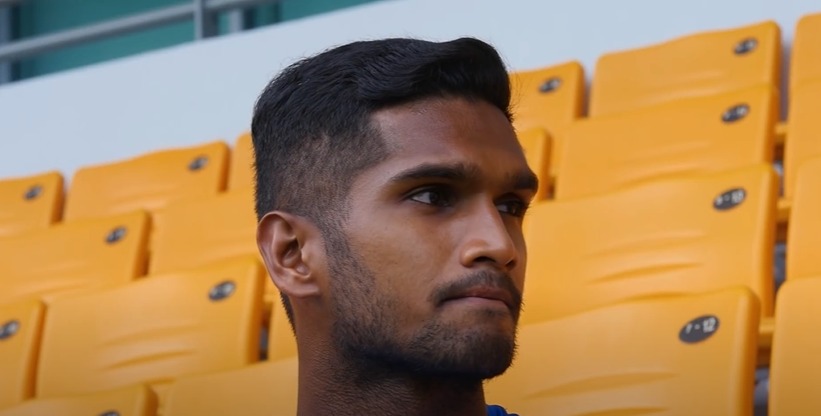The unwavering midfield general that Singaporean football supporters have long admired, Hariss Harun, has never been one to make headlines. However, his pay statistics, especially those from his time at Johor Darul Ta’zim (JDT), have provoked important discussions throughout ASEAN. According to reports, Hariss was making S$43,000 a month in 2015. That was a revelation at the time, not just a raise. For the regional football player, those figures resonated well beyond the field, redefining what success for Southeast Asian athletes might entail.
Hariss was cashing paychecks that were comparable to those of high-level executives during a time when local professionals frequently juggled full-time jobs with football commitments. Just the visuals were revolutionary. His contract wasn’t just rich; it had symbolic meaning, especially for a generation that was raised to see sports as pastimes rather than serious careers. In a culture that frequently encourages athletes to have backup plans, Hariss’s financial success offered a fresh model.
| Attribute | Details |
| Full Name | Hariss bin Harun |
| Date of Birth | 19 November 1990 |
| Nationality | Singaporean |
| Current Club | Lion City Sailors |
| Playing Position | Defensive Midfielder / Centre-back |
| Club Number | 14 |
| Youth Club | National Football Academy (2003–2007) |
| Senior Career Highlights | Young Lions, LionsXII, Johor Darul Ta’zim, Home United, Lion City Sailors |
| National Team Appearances | 140 caps, 11 goals |
| Estimated Salary (2024) | US$30,000 (S$43,000) per month |
| Notable Awards | S.League Young Player of the Year (2010), AFC Cup Champion (2015) |
| Reference Link | Wikipedia – Hariss Harun |
Hariss capitalized on a trend that was gaining traction throughout Asia—clubs investing in player retention as well as facilities—by placing a wager on local ambition rather than international adventure. The Crown Prince of Johor led JDT’s management, which was remarkably creative in rethinking local football. They established an ecosystem that allowed for the existence of top-tier wages without the need for overseas migration by putting a focus on professionalism, global scouting systems, and European-grade infrastructure.

The story nearly took a different turn in 2013. With the help of Singapore billionaire Peter Lim and Cristiano Ronaldo’s agent Jorge Mendes, the Portuguese team Rio Ave had made an approach. It appeared to be finalized. However, issues surfaced, primarily related to salary disputes and National Service commitments. Once viewed as a setback, that detour ultimately helped Hariss advance into a much more significant position in regional football.
Hariss become the highest-paid Singaporean football player of his generation instead of being another name in a European reserve team. In addition to elevating him, his success quietly changed the way Singaporean youth athletes perceived their own athletic potential. It established a standard. His agreement was remarkably successful in establishing a precedent and establishing football as a financially viable career option for Southeast Asians.
Surprisingly, Hariss’s story isn’t just about his wealth. It also has to do with his diversification. When Hariss entered the real estate market in late 2023, as his playing days were coming to an end, it was a glaring indication that he was preparing for life after football with the same focus that had molded his career. This action is similar to other examples around the world: Juan Mata studied entrepreneurship and philanthropy, while Patrice Evra studied business education. With one foot in the boardroom and another still rooted on the field, Hariss appears to be adhering to that practical tradition.
His wealth also reveals a more general reality: sports success is no longer restricted to particular regions. JDT’s aggressive investment strategy has had a similar knock-on effect in ASEAN to how Major League Soccer strengthened its player pool with high salaries. In that situation, Hariss became a beacon and a beneficiary.
The discussion surrounding his pay gets even more complex on a societal level. In Singapore, academic success has long been valued more highly than athletic ability. Strong infrastructure was even harder to find than scholarships for top athletes. However, Hariss’s grit-filled, consistency-based career offers a compelling counter-narrative. It suggests that Southeast Asian athletes can succeed—and make money—without sacrificing anything if the proper conditions are met.
Naturally, there is a fragility associated with high earnings in sports. Even though Hariss’s career was mostly successful, there were some physically taxing times. He could have easily lost momentum due to injuries like a torn ligament or a broken fibula. By persevering through those setbacks, he protected his financial future in addition to maintaining his form. His tenacity highlights a crucial lesson: discipline guarantees that you remain in the room, even though talent opens doors.
If anything, Hariss Harun’s financial trajectory demonstrates that significant achievement is not limited to American leagues or European academies. For athletes throughout Southeast Asia, his trajectory—which is based on timing and strengthened by calculated choices—is incredibly motivating. Hariss provides something unique—a road map filled with both ambition and reward—for young football players who aren’t sure if their dreams can lead to a living.
